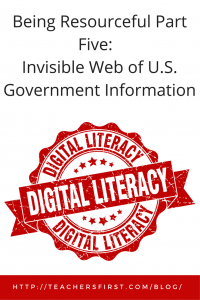 Several months back we began discussing research. Now, let’s take a look at the best resources that students and teachers can use to meet their information requirements. The research process begins with a motivation, either personal or external, such as a class assignment. The best class assignments are authentic tasks, problems the learner must solve doing real-life activities that are student-driven, structured, and use direct evidence that leads to construction and application.
Several months back we began discussing research. Now, let’s take a look at the best resources that students and teachers can use to meet their information requirements. The research process begins with a motivation, either personal or external, such as a class assignment. The best class assignments are authentic tasks, problems the learner must solve doing real-life activities that are student-driven, structured, and use direct evidence that leads to construction and application.
As students begin searching for direct evidence, the invisible web offers some of the highest quality sources that can also be the most difficult to find. Check out this article from Lifewire for more invisible web suggestions.
Primary sources may be the most challenging and hardest to locate. A previous blog post offered many suggestions. The most extensive primary sources are in our own United States government websites, and federal online sources include information on almost every topic. The added benefit for students using these government web portals and search engines is that almost all are ad-free, clean, user-friendly, and easy-to-use.
While there are a bewildering array of government agency websites to search for information, unfortunately, often these pages do not appear in the results from the most popular search engines. One quick way to find information in these places is to teach students to narrow their searches by using “.gov” as a domain limiter available, for example, in Google’s advanced search. Watch this OK2Ask webinar for even more tips on using Google search secrets.
Another way to teach students how to find government information is to use search-specific, global searches, and web portal sites. Place these links on your classroom or school library website, show students how to use the searches, and require students’ research to include these types of resources. Here are some basic ones to include.
For our younger students grades K through 8, Kids.gov is a great place to begin. Kids.gov is the official children’s portal for the U.S. government. The site’s purpose is to link “kids, parents, and teachers to information and services on the web from government agencies, schools, and educational organizations, all geared to the learning level and interest of kids.” Kids.gov is very easy to use and finds links to all types of information suited to children’s reading levels, school subjects. It also includes separate sections for online games & videos. Lesson plans, activities, and worksheets make it valuable for teachers, too.
For older students and adults, another gem is the web portal USA.gov and a companion site, Data.gov. USA.gov’s mission, is “to create and organize timely, needed government information and services and make them accessible anytime, anywhere, via your channel of choice.” Similar to Google, USA.gov has some helpful search delimiters that sort all results, images, and videos. The search engine checks other .gov sites, such as state websites, but results can be limited to federal agencies. Data.gov, an amazing site, provides raw data that can be downloaded and used in spreadsheet programs. Math teachers will love what’s here. This TeachersFirst review has tips on how to use it in class.
A staple of library reference collections, The Statistical Abstract of the United States was discontinued in 2011. However, the Census Bureau now shares much of that data through its website and the companion Factfinder. Find statistics gathered from our national census-taking. You can easily locate national, state and local statistics on all kinds of topics so that students can back up their research with facts and primary sources.
The first global search engine for U. S. government-related information was the breakthrough site called Thomas. In 2016 Thomas transitioned to Congress.gov, the official web portal for U.S. federal legislative information. The site “provides access to accurate, timely, and complete legislative information for Members of Congress, legislative agencies, and the public.” Younger students may want to use Ben’s Guide to the U.S. Government, an interactive site with lots of information on how the federal government works, plus kid-friendly games and activities.
The U. S. government does a commendable job making information researched, gathered and supported by our tax dollars accessible to all citizens. Take some time during the summer break to explore these federal sites, explore the search possibilities, and think how to include these websites in your students’ authentic research. In the future, we will look at some specific subject-related U. S. government websites that you and your students will find both helpful and fun.

